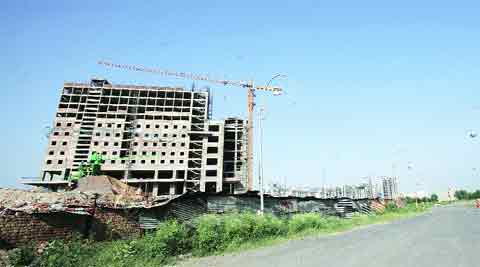
Two more districts of Haryana will soon be included within the NCR, a year after the last expansion. While the new entrants can look forward to several benefits, the principal objective of decongesting Delhi is far from being met.
With elections round the corner, the Union government has decided to expand the areas included under the National Capital Region (NCR) with the districts of Jind and Karnal in the state of Haryana all set to be brought in.
The NCR accounts for 7.6 per cent of the country’s urban population and has also come to acquire the distinction of the “world’s largest urban agglomeration.” The state governments of Haryana, Rajasthan and Uttar Pradesh have been pitching to include more districts from their states within the NCR with an eye on the benefits of being close to Delhi — in the form of real estate development, soft loans for infrastructure projects, greater investment activity in the state and development.
Haryana goes to elections in October this year and the inclusion of the two districts are being seen as an attempt to win over the population in the face of the growing presence of the Aam Aadmi Party (AAP) in the state.
“We have proposed to include Jind and Karnal in the NCR, the final decision will be taken when the Board meets on Monday,” said a senior Haryana government official. There is a request from the Uttar Pradesh government too, to include Agra within the NCR fold.
The NCR currently includes 19 districts spread across three states and the National Capital Territory of Delhi. In Haryana, it comprises the districts of Faridabad, Gurgaon, Mewat, Rohtak, Sonepat, Rewari, Jhajjhar, Panipat, Palwal, Mahendragarh and Bhiwani. In Uttar Pradesh, the districts of Meerut, Ghaziabad, Gautam Budh Nagar, Bulandshahr, Hapur and Baghpat are included. The districts from Rajasthan are Alwar and Bharatpur.
The NCR last underwent an expansion in July 2013 when three districts — Mahendragarh, Bhiwani and Bharatpur were added to it. Along with Delhi, the total area under the NCR now constitutes 45,887 sq km. Delhi alone accounts for 4.4 per cent of the population of the region.
A senior official at the Union urban development ministry official said, “There are serious considerations to rework the NCR region.”
Inclusion in the NCR also means easing pressure off Delhi, which regularly sees massive migration from neighbouring states.
Planning for the NCR is undertaken by the National Capital Region Planning Board (NCRPB), which is headed by the Union urban development minister and has representatives from the three states that are part of the region. With the inclusion of the two additional districts, the regional planning exercise would now be done under the overall direction of the NCRPB. Infrastructure can be built with greater support from the Union government, and in addition, planning would be holistic with a clear strategy.
As per the NCRPB estimates, urbanisation in NCR has increased from 50 per cent in 1991 to 62 per cent in 2011. With the rapid growth of the Central National Capital Region (CNCR) area, Metro Centres and Regional Centres, the Delhi-Mumbai Industrial Corridor (DMIC) currently underway, and the Dedicated Freight Corridor (DFC), the urbanisation level of NCR is expected to reach 73 per cent by 2021.
The rapid urbanisation has also affected the environment with green areas in the region reducing from 4.26 per cent in 1999 to 3.30 per cent in 2012, which is much lower than the proposed green areas of 10 per cent in the Regional Plan 2021.
NCR is endowed with ecologically sensitive areas like the Aravalli ridge, forests, wildlife and bird sanctuaries, rivers, lakes, ponds which are facing constant threat of encroachment by urban and construction activities. “Judicious and careful planning for conservation of these eco-sensitive areas and their adjoining areas especially within the urbanisable areas and controlled areas of cities/towns is a major challenge,” a report by the NCRPB states.
Former chief minister of Delhi, Sheila Dikshit had said during the meeting of the Board in July last year, that towns like Noida and Gurgaon have not served their purpose in decongesting the capital. “The burden of increased migration cannot be borne by Delhi alone. For example, figures show that between 32 to 36 per cent of patients in government hospitals in Delhi are from outside the city. To ensure a better future, we need to plan better,” Dikshit had said then. She had emphasised that waste management and housing shortage also needed to be considered.
According to the NCRPB draft Revised Regional Plan 2021, 10 districts in Uttar Pradesh alone accounted for 17.32 per cent of migrants to Delhi. The districts include Bulandshahr, Aligarh, Meerut, Ghaziabad and Agra. Five districts in Bihar including Madhubani, Darbhanga and Patna account for 7 per cent, followed by Haryana, Uttarakhand, Jharkhand and West Bengal.
One aspect of planning that has not received serious consideration is the development of the latent tourism potential in these districts and the preservation of heritage sites, which would now be brought within the ambit of the Board. Usually, rapid urbanisation takes a toll on heritage sites, which are seldom preserved.
There are 258 Centrally protected monuments under the Archaeological Survey of India and 20 state-protected monuments under the state archaeological departments in the constituent states of the NCR. Of these states, Delhi has the highest number of Centrally protected monuments at 166, followed by Haryana at 63 and Uttar Pradesh at 26 and a similar number for Rajasthan.
There are a large number of monuments that are unprotected, which would get a new lease of life under a holistic plan.
“Despite the sharp increase in tourist arrivals in India in recent years, the region’s share of world tourism remains insignificant.
NCR’s connectivity is limited and focal to Delhi, thus acting as a constraint to tourism growth in the region. There is only one major domestic and international airport at New Delhi, restricting the air access within the region,” said another official at the urban development ministry.
The official added that the NCR is not linked very well with an intra-regional road network. Currently, national and state highways serve as the major road connections within the NCR, but there are several lags in last-mile connectivity, which can stall the tourism potential in the region.
In order to provide easy and quick access to these destinations within the NCR, the government is planning a tourist-specific multi-modal transit facility planned ranging from helicopter services and intra-regional taxi services the official said. The Board is developing a tourism plan for the region and would be meeting soon on the issue.

